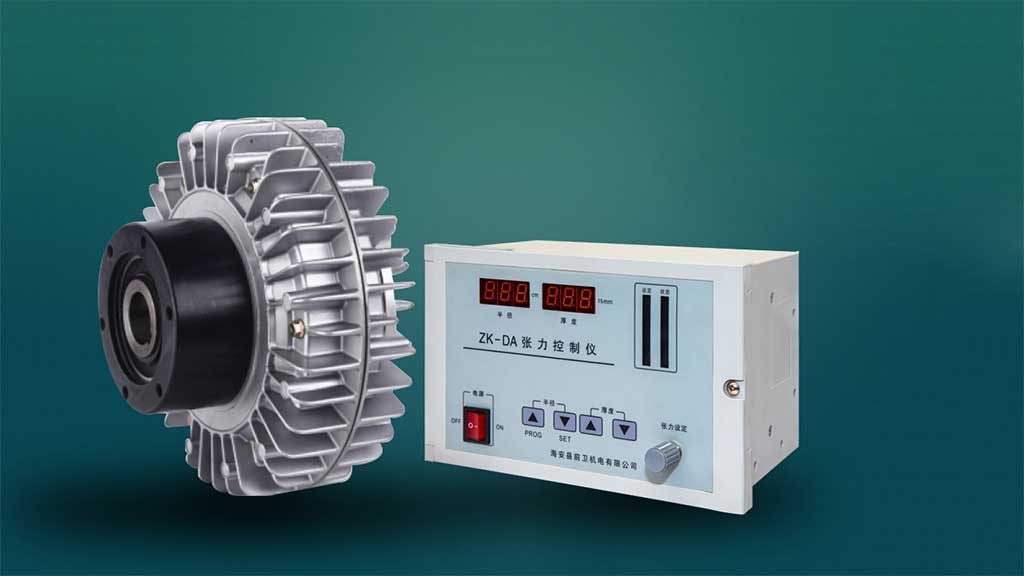In many industrial applications, maintaining proper tension in material webs or continuous processes is crucial for optimal operation. Magnetic particle brakes offer an efficient and reliable solution for tension control. In this article, we will explore the working principles of magnetic particle brakes, their applications in tension control systems, and the advantages they offer over other braking mechanisms.
- Working Principles: Magnetic particle brakes operate on the principle of magnetorheological fluid, which is a smart fluid that changes its rheological properties in the presence of a magnetic field. These brakes consist of a stationary coil and a rotating input/output shaft, with the magnetorheological fluid in between.
- Torque Transmission: When the coil is energized, a magnetic field is generated, causing the magnetorheological fluid to solidify and transmit torque from the input to the output shaft. Adjusting the coil current allows for precise control of the transmitted torque.
4 Tension Control Applications
Magnetic particle brakes find extensive use in various industries where tension control is critical. Let’s explore some common applications:
- Web Processing and Converting: Magnetic particle brakes are widely employed in web processing and converting applications, such as printing presses, laminating machines, slitting machines, and coating lines. They provide accurate and responsive tension control, ensuring proper web handling and preventing issues like wrinkles, stretching, or material breakage.
- Textile Industry: Tension control is crucial in textile processes like weaving, knitting, and winding. Magnetic particle brakes enable precise control of yarn tension, resulting in improved fabric quality, reduced defects, and increased productivity.
- Packaging and Labeling: Magnetic particle brakes play a vital role in packaging and labeling machines, ensuring consistent tension during the unwinding and rewinding processes. This helps prevent material slippage, wrinkling, or misalignment, leading to efficient packaging operations and high-quality output.
- Wire and Cable Manufacturing: In wire drawing, extrusion, and cable manufacturing, maintaining proper tension is essential for uniform product quality. Magnetic particle brakes provide accurate tension control, preventing wire breaks, elongation, or inconsistencies in cable diameter.

5 Advantages of Magnetic Particle Brakes
Magnetic particle brakes offer several advantages over other braking mechanisms, making them a popular choice for tension control. Let’s explore their key benefits:
- Precise and Responsive Control: Magnetic particle brakes provide precise torque control, allowing for accurate tension adjustment in real-time. They respond quickly to changes in coil current, enabling rapid adjustments to maintain desired tension levels.
- Wide Torque Range: Magnetic particle brakes can handle a wide range of torque requirements, making them suitable for various applications, from delicate materials to heavy-duty industrial processes.
- Smooth and Consistent Operation: The magnetorheological fluid in magnetic particle brakes ensures smooth torque transmission without jerks or fluctuations. This leads to consistent tension control and high-quality output.
- Non-contact Operation: Magnetic particle brakes operate without physical contact between the braking surfaces, minimizing wear and reducing the risk of damage to the material being processed. This is especially beneficial for delicate or sensitive materials.
- Low Maintenance: Magnetic particle brakes require minimal maintenance due to their simple design and non-contact operation. This results in reduced downtime and increased productivity.
Final Words
In conclusion, magnetic particle brakes provide an efficient and reliable solution for tension control in various industrial applications. By utilizing the unique properties of magnetorheological fluid, these brakes offer precise and responsive torque control, ensuring optimal tension levels in processes like web handling, textile manufacturing, packaging, and wire/cable production.
The advantages of magnetic particle brakes, such as their precise control, wide torque range, smooth operation, non-contact nature, and low maintenance requirements, make them a preferred choice for tension control systems. When implemented correctly, magnetic particle brakes contribute to improved product quality, increased productivity, and enhanced overall efficiency.